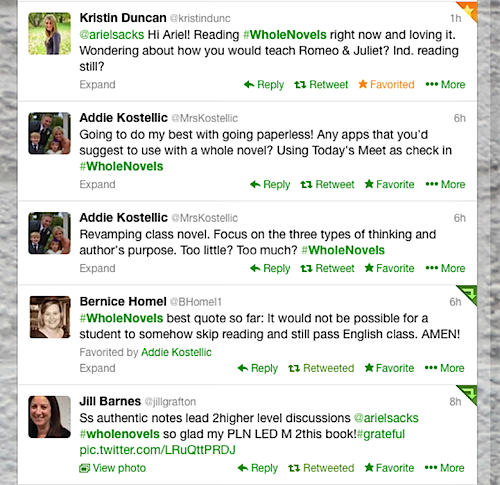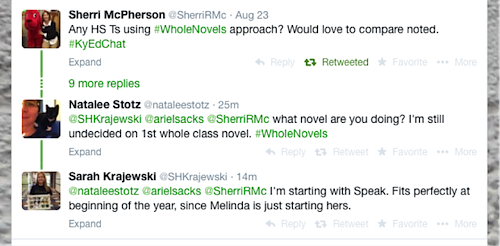An Author & Her Readers Collaborate Online

I imagine that writers in the old days, or even just 20 years ago, would publish a book and likely never know much about its impact. Maybe authors received occasional fan mail, and even more occasionally, started a correspondence with a reader. But I imagine it was hard to really know how readers were responding.
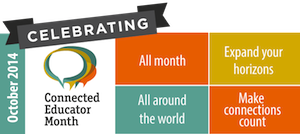
Let me first say that, after writing and revising Whole Novels for the Whole Class: A Student Centered Approach and receiving the first print copy from Jossey Bass last October, I was prepared to rejoice in the accomplishment—and let the thing go. Although I had plans that I hoped would lead to more exciting places, I was prepared for the strong possibility that I’d never really know what became of my work.
What has actually happened with my book has exceeded even my wildest hopes, though! Through the wonders of the Internet, and especially Twitter (special thanks to #ELAchat), I’ve not only been able to hear back from readers of my book – I’ve been able to develop conversations with teachers from all over the country (and beyond) who are actually implementing and adapting my methods in their own classrooms.
The best kind of collaboration
Like a parent who’s thrilled at any positive news of her child, nothing could be more exciting to this teacher-author than to know that other educators are trying out these ideas and finding success.
I’ve been able to be a live resource to teachers as they implement the teaching of whole novels, answering questions through Twitter, Facebook, and even email. What’s more, I’m learning from other teachers’ interpretations of the method, their thoughtful questions, and their new ideas.
Best of all, teachers who publicly share their #WholeNovels reflections and innovations then become resources to others online. I would cautiously say that what is growing is a grassroots, entirely teacher-driven movement to incorporate the whole novel method into English classrooms, increasing student voice, autonomy, and community in the study of literature. I think of us all as pioneers.
Colleagues teaching colleagues
While I’ve been blown away by the level of response from teachers, I also know that there are some choices I made in presenting the book that favor collaboration over control and therefore invite meaningful dialogue. Throughout the writing process and in online communication, I’ve always thought of myself as a colleague to other teachers, not some “authority” operating at arms’ length.
I do view myself as an expert on the whole novels method my book proposes (I invented a lot of it, after all), but I also know that many teachers reading my book are expert teachers themselves. Even beginning teachers know more about their own teaching contexts than I do.
My own expertise is somewhat limited to 7th and 8th grade classrooms in New York City, though I know the method can be applied to any literature classroom. And I’m counting on teachers to utilize all their knowledge and experience as they go about making the ideas fit their own situations.
I established a website early on to support the book, where I intended to keep a blog about my continued adventures teaching whole novels. But the adventures that I’ve become most excited to share (and read about myself) are not my own, but those of the other teachers who are exploring whole novels in their classrooms.
I began asking teachers to write about their experiences. As an advocate for teacher leadership, I’ve always believed that writing publicly about our work was an important step toward becoming an empowered profession, so I had an added layer of motivation to go in this direction.
Some teacher-bloggers have published their reflections on whole novels on their own blogs:
- Joel Pardalis showed how he’s integrating new technologies into whole novel studies;
- Nancy Wahl and Ken C both shared their unique processes applying the whole novel approach with Elie Wiesel’s memoir, Night;
- Joy Kirr kept a daily log of her reflections as she implemented a whole novel study of The Outsiders;
- Sarah Krajewski blogs about her plans to implement the method in her high school English classes.
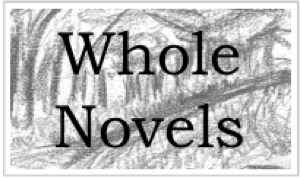
- Lea Jones writes about whole novels in 5th grade;
- Stefanie Cole has written a series on her realizations at various stages of implementation;
- Jill Barnes blends whole novels with other recent PD books and writes about the shift to student-driven whole novel discussions;
- Alicia Hunter describes her process of bringing more student choice to whole novel studies.
Loneliness gave way to like-mindedness
There are times when being a radically student-centered teacher is lonely. I like and respect a wide variety of teachers, but I’m unapologetically passionate about pedagogy that puts students in the driver’s seat and provides authentic experiences. Sometimes (though not always), it’s been hard to find other teachers in my building as interested in pursuing this as I am.
Ironically, writing a book, which is such a solitary activity, has connected me with so many like-minded teachers across geographical boundaries. I’ve even now met many of my Twitter pals in person, visited their schools and supported their teams to adapt whole novels for their students. We are far from alone!
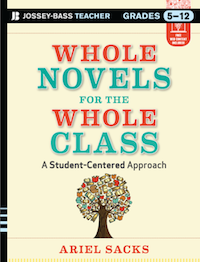
My work with the Center For Teaching Quality around teacher leadership (which I began as a novice educator) has taught me that teachers collaborating and sharing expertise is the lever that has the potential to change education for the better, probably more than any other initiative.
Seeing how many teachers are seeking out the professional development that inspires them by organizing edcamps, book clubs and lesson studies – and building connected learning networks where they eagerly collaborate with and support other teachers they’ve never met – makes me feel more hopeful than ever about the future of our profession.
Ariel Sacks teaches 8th & 9th grade English Language Arts in New York City. She is proud to say this is her 11th year of full time classroom teaching. Throughout her career, she has worked with a wide range of diverse learners both in the city school district and currently in a public charter school. She studied progressive pedagogy at Bank Street College of Education, where her mentor and longtime collaborator, Madeleine Ray, first introduced her to the whole novel concept.
Ariel writes the widely followed blog, On the Shoulders of Giants, and has published articles in Education Week and Education Leadership. An advocate for teacher leadership, she is a co-author of Teaching 2030 (2011) and is featured in the 2013 book, Teacherpreneurs: Innovative Teachers Who Lead Without Leaving.

